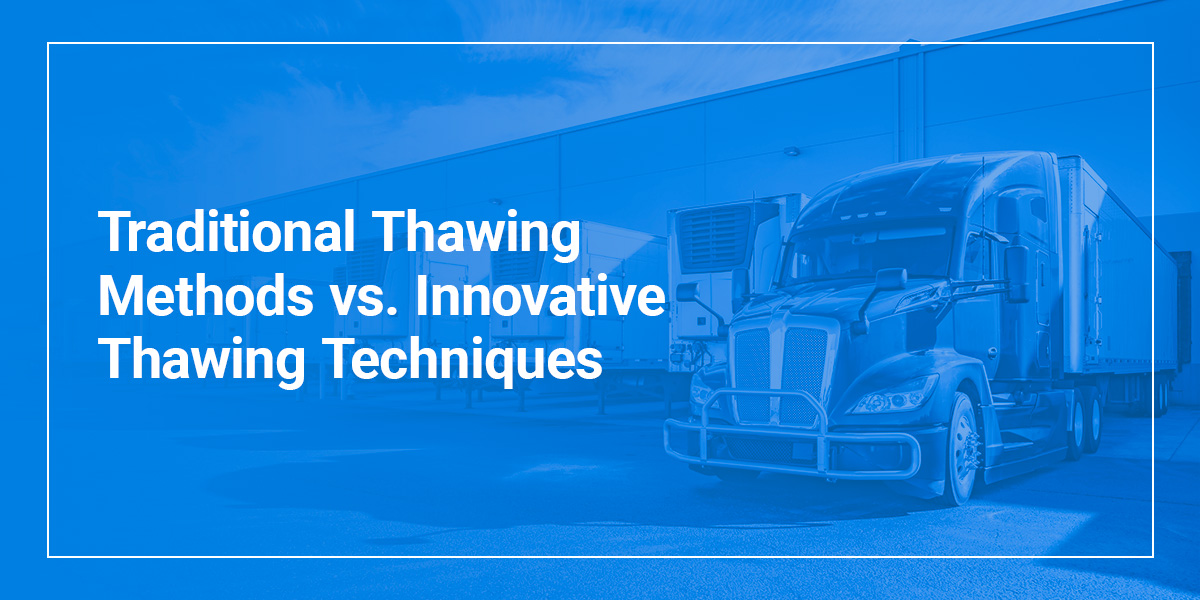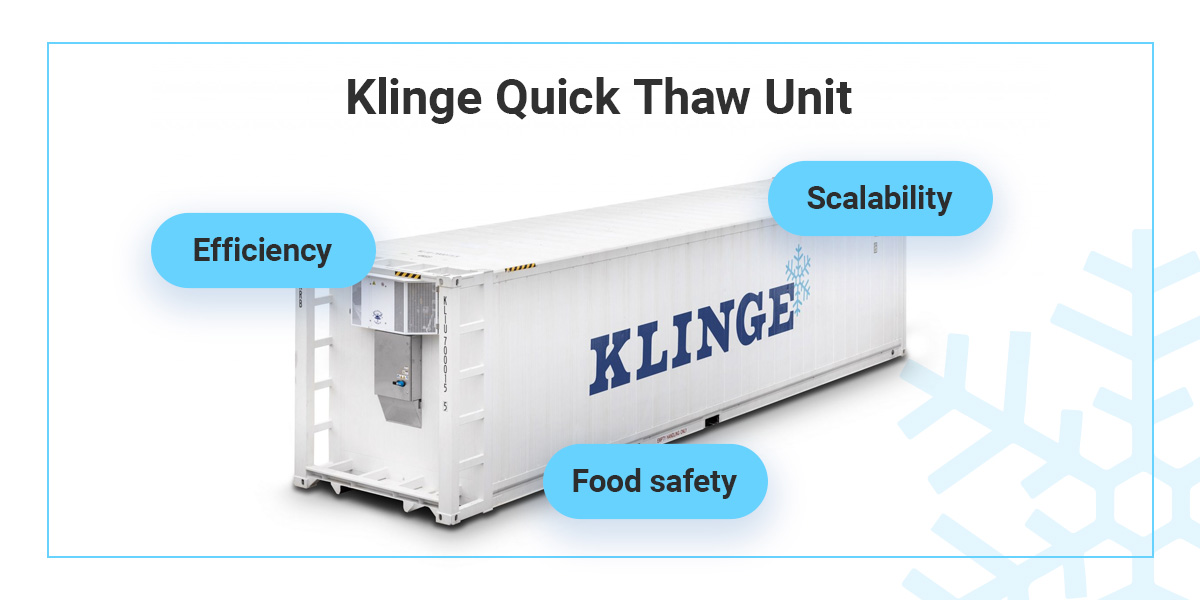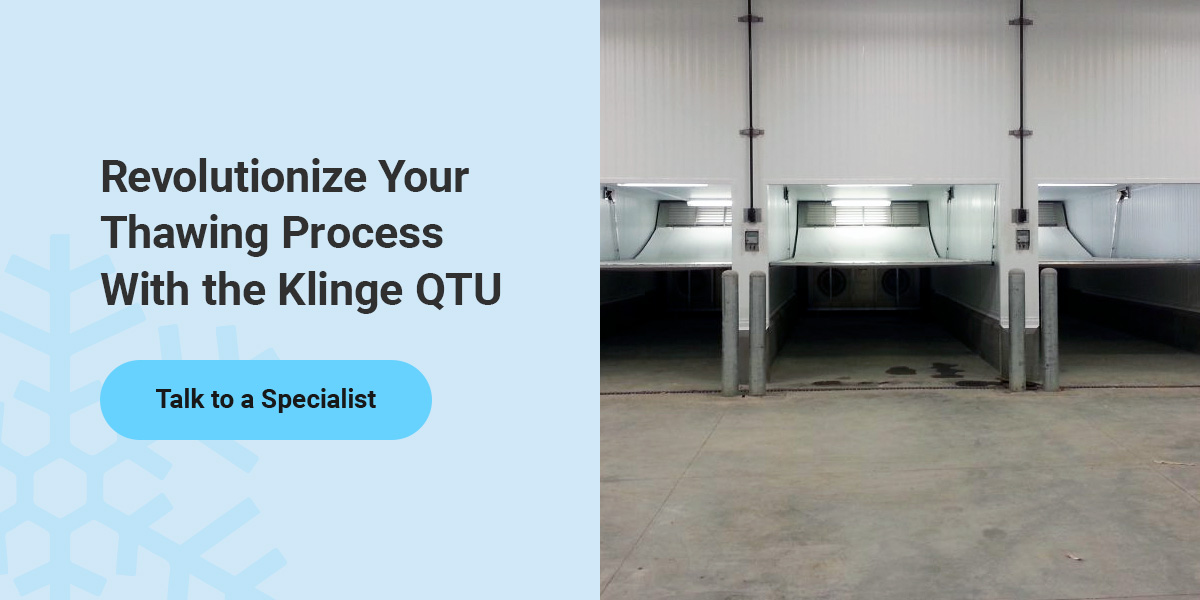In cold chain logistics, how you thaw frozen goods is just as important as how you freeze and store them. Poor thawing practices can compromise food safety, reduce product quality and decrease revenue. Food processors must invest in efficient defrosting methods to improve efficiency and profitability.
The Importance of Safe Thawing Methods for the Food Industry
Thawing frozen foods requires more than a simple home refrigerator. Businesses use temperature control methods to prevent spoilage and bacterial growth. Inconsistent or unsafe tempering can lead to illness, drip loss and poor texture. Sending out unsafe products can result in regulatory and reputational risks.
The Food Safety Modernization Act sets the standards for safe food practices like thawing. Failure to follow relevant regulations puts you at risk for fines and product suspension. A reliable defrosting process keeps your products consistent, protecting your company.
Traditional Thawing Methods
Many businesses rely on traditional tempering methods out of habit. It might seem simpler to keep using the old system that has worked for years. However, traditional methods are slower and more limited, preventing scaling with growth and reducing efficiency.
Common thawing techniques include:
- Refrigerators: This is considered the safest traditional method. Refrigerator defrosting keeps food at a consistently low temperature while it defrosts. However, this technique is slow — it can take 24 hours for every 2.27 kilograms (5 pounds) of product. This delay backs up large operations and increases storage demands.
- Cold water: Using cold water speeds up defrosting compared to refrigeration. Submerging sealed products into the water thaws faster than refrigeration, but it requires constant water circulation or changes to prevent the temperature from hitting unsafe zones.
- Air or room temperature: Some facilities use ambient air temperature for convenience. However, it comes with serious safety risks. Surface temperatures rise rapidly, exposing the product to the bacterial danger zone of 4 degrees Celsius to 60 degrees Celsius (40 degrees Fahrenheit to 140 degrees Fahrenheit).
- Microwaves: Microwave defrosting is fast but leads to uneven thawing and partial cooking. Commercial-scale systems are expensive, complex and challenging to install.
Pros and Cons of Traditional Thawing Methods
Traditional thawing can work, although slowly. Air tempering is a food safety hazard since products warm up into the danger zone, but the other methods offer some benefits. However, these techniques lack the speed and consistency of newer methods.
Pros of traditional defrosting include:
- Low initial cost: Refrigerator and cold water techniques involve minimal equipment investment. Just set up the refrigerator or water system and let time do the work.
- Simple: Similarly, these methods require little to no staff training. Show them proper product movement, handling and monitoring. Then, just have them wait until everything is thawed.
Cons of simpler methods include:
- Time-consuming: Traditional methods are slow. Waiting around for hours to bring food up to temperature is time you could be moving products through production.
- Food safety risks: Improperly managed cold water or air defrosting exposes food to safety risks. Danger zone temperatures let bacteria multiply rapidly, increasing the risk of spoilage or illness.
- Quality degradation: Uneven thawing from microwaves or cold water methods can create poorer-quality meat or unwanted textures. Too-warm outer layers with frozen cores lead to moisture retention and flavor issues.
- Labor-intensive: All traditional methods require constant supervision to ensure even cooling and safety. These labor demands slow down high-volume operations.
Klinge Quick Thaw Unit
Directors and managers looking to modernize tempering can turn to innovative thawing technologies for support. The Klinge Quick Thaw Unit (QTU) offers a proven, high-performance solution that outpaces traditional techniques. The Klinge QTU is designed for efficiency, food safety and scalability. Use it to increase throughput without sacrificing quality or compliance.
Key Features
The Klinge QTU was developed to be one of the most effective thawing methods for the food industry. Its advanced features work to make commercial processes easier and safer. Some of its features include:
- High capacity: The QTU can thaw up to 10,000 kilograms (about 22,000 pounds) of product in just 36 to 48 hours. It’s highly effective for high-volume processing facilities. Plus, this level of throughput streamlines production and reduces storage time and space.
- Intelligent control: Klinge’s intelligent controller uses a probe network to monitor core and surface temperature during defrosting. It automatically adjusts airflow and temperatures to ensure uniform thawing. This control reduces drip loss and preserves product quality.
- Automatic cooling mode: After tempering, the unit automatically switches to a holding mode, keeping the product at the desired temperature. Facilities can plan around production schedules, eliminating immediate unloading and reducing off-shift labor.
- Data logging: Built-in data logging fully tracks each thawing cycle. Real-time monitoring and downloadable logs support internal quality assurance and help you meet regulatory standards. Use this data for proof of process control and consistency.
- Flexible installation: The QTU comes in two configurations. The containerized version is highly flexible — transport it to other facilities as needed. The built-in version integrates with production lines, reducing internal transport time between defrosting and processing.
QTU Pros and Cons
The QTU is built for industrial operations with high standards. This innovative food thawing technology simplifies the defrosting process while maintaining food quality.
Pros of the QTU include:
- Efficiency: With faster cycle times and large-capacity handling, the QTU increases overall throughput and reduces bottlenecks.
- Enhanced food safety: The QTU preserves food safety by maintaining consistent temperatures, constantly logging data and preventing temperature fluctuations.
- Improved product quality: This system provides uniform tempering and minimizes drip loss, protecting product quality and yield.
- Labor savings: Automated start times, intelligent controls and post-thaw storage reduce the need for constant supervision and manual handling.
- Regulatory compliance: Temperature logs support Hazard Analysis and Critical Control Points (HACCP) so you can prove compliance for certifications and audits.
The QTU has two main initial limitations:
- Initial cost: The QTU is advanced industrial equipment, so it has a higher upfront cost than traditional methods. However, the long-term gains quickly offset this cost.
- Training required: Operators will need to be trained on a new system. However, setup is straightforward, and the QTU is designed for ease of use once operators understand the basics.
Revolutionize Your Thawing Process With the Klinge QTU
Don’t settle for outdated thawing methods when safety, quality and performance matter. Klinge Corporation’s QTU is engineered for food processors who need speed and consistency without compromising compliance. With over 40 years of experience and a commitment to customer satisfaction, we have the tools to help you meet your temperature needs.
Our mission is to support high-stakes industries that need precise cold chain operations. Whether you need a portable containerized unit or a built-in solution for your facility, Klinge delivers unmatched performance. Our work is backed by an ISO 9001:2015 certification and decades of engineering excellence. Contact us today to discuss your thawing needs and get a custom quote!
Linked References:
- https://www.cdc.gov/restaurant-food-safety/php/investigations/proliferation-contributing-factors.html
- https://www.fda.gov/food/guidance-regulation-food-and-dietary-supplements/food-safety-modernization-act-fsma
- https://www.fsis.usda.gov/food-safety/safe-food-handling-and-preparation/food-safety-basics/freezing-and-food-safety
- https://www.fsis.usda.gov/food-safety/safe-food-handling-and-preparation/food-safety-basics/big-thaw-safe-defrosting-methods
- https://pmc.ncbi.nlm.nih.gov/articles/PMC10987380/
- https://klingecorp.com/thawing-units/
- https://klingecorp.com/blog/commercial-thawing-equipment-guide/
- https://klingecorp.com/blog/klinge-quick-thaw-unit-success-story/
- https://www.fda.gov/food/hazard-analysis-critical-control-point-haccp/haccp-principles-application-guidelines
- https://klingecorp.com/food-processing/
- https://klingecorp.com/about/#quality
- https://klingecorp.com/about/contact-us/



